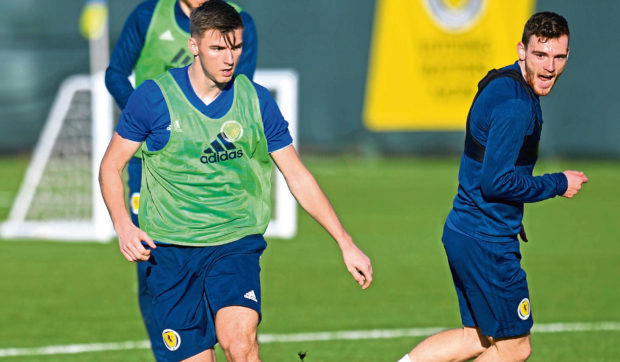
With Liverpool’s marathon season finally over, Andy Robertson can luxuriate in one of the finest holiday spots money can buy – and Covid-19 considerations allow.
It is hugely deserved.
At the start of the virus-interrupted 2019-20 campaign, the Scotland skipper was already a Champions League winner.
At its end – almost 12 months later – he is also a Premier League and World Club champion.
Throw in the Super Cup success, and Liverpool’s campaign was just about perfect.
Robertson, who delivered a dozen assists in the league alone, was integral to their success.
Even with all that glory to look back on, however, there is a fly in the ointment.
He is, in his own words – delivered on a recent podcast – “sick to the death” of the constant comparisons made back home in Scotland between himself and Kieran Tierney.
The bad news for the 26-year-old is that it is fast becoming a thing south of the border too.
Tierney’s tenacious displays for Arsenal have been winning him lots of love, from the home support at the Emirates to former Gunners stars in the media, with Martin Keown just the latest to sing the defender’s praises.
Their backing hasn’t gone unnoticed, with English pundits now posing the question that also has to be on Steve Clarke’s mind ahead of October’s Nations League play-offs.
Just who is the best Scottish left-back?
Danny Murphy, the ex-Liverpool and England midfielder, came down firmly in the Robertson camp during the week when stating the former Queen’s Park kid is at a level he is not sure Tierney is capable of reaching.
He should not require the reassurance.
Being compared – favourably – to a £25-million Arsenal star is pretty much the definition of a First World problem.
It happens to even the very best players, and does so because it allows the media to discuss the relative merits of special talents.
The debates are enjoyable and they mirror the sort of chat fans will be having themselves, be it online, socially-distant or in pubs.
They are also fun to look back on in future years.
When Cristiano Ronaldo signed for Manchester United in 2004, aged just 18, he was dubbed “the new Figo” and, as remarkable as it seems now, “the Portuguese Ronaldo”!
The latter nickname was in deference to his Brazilian namesake, a two-time Ballon d’Or winner, who these days is, less kindly, often tagged “the fat Ronaldo”.
Back then, of course, the media had no way of knowing the phenomenon Cristiano would become, with the Manchester Evening News in mischievous form with a vox pop which posed the question: “Will Ronaldo be the new, err, Ronaldo? Have your say!”.
Five World Player of the Year awards supply the answer.
Cristiano has not just matched him, he has surpassed him to make good on his teenage pledge to introduce everyone to his own unique style of play.
In the process, he has invited comparisons with Messrs Messi, Maradona and Pele, in the much-loved “who-is-the-Greatest-Player-of-all-time?” debate.
The little Barcelona wizard can boast a record six Ballon d’Ors to his name.
For fifty-something football fans such as yours truly, the answer will likely be the mercurial Diego, with or without his Hand of God.
Pele, of course, can say to them all: “Get back to me when you win three World Cups.”
More pertinently, Andy Robertson also has a lesson on the best way to deal with comparisons – with a smile.
Asked by a reporter once how his fame stacked up to that of Jesus, he did not miss a beat.
“There are parts of the world where Jesus Christ is not so well-known.”
For all Tierney’s rapid progress, Robertson can rest easy when it comes to Scotland.
Steve Clarke, like his national coach predecessors, will undoubtedly take a pragmatic approach to the left-back conundrum, and look to play both men in his starting line-up.
And here Arsenal manager, Mikael Arteta, has done him a favour by deploying Tierney on the left side of his central defence in recent weeks.
David Luiz has covered for the Scot’s lack of height with the Gunners. Declan Gallagher of Motherwell or Leeds United’s Liam Cooper could easily do a similar job in dark blue.
Clarke deploying a 3-5-2 formation would allow Robertson to be pushed on into an advanced role, much as Bukayo Saka has been at the Emirates.
For the Nations League play-offs against Israel and – with a bit of luck – Norway or Serbia, the formation would provide the attacking impetus needed to win through to Euro 2020.
If we get to the Finals, sterner opposition will be lying in wait.
So the Robertson-or-Tierney headache could return to trouble Clarke.
It would be a nice problem to have.

Enjoy the convenience of having The Sunday Post delivered as a digital ePaper straight to your smartphone, tablet or computer.
Subscribe for only £5.49 a month and enjoy all the benefits of the printed paper as a digital replica.
Subscribe